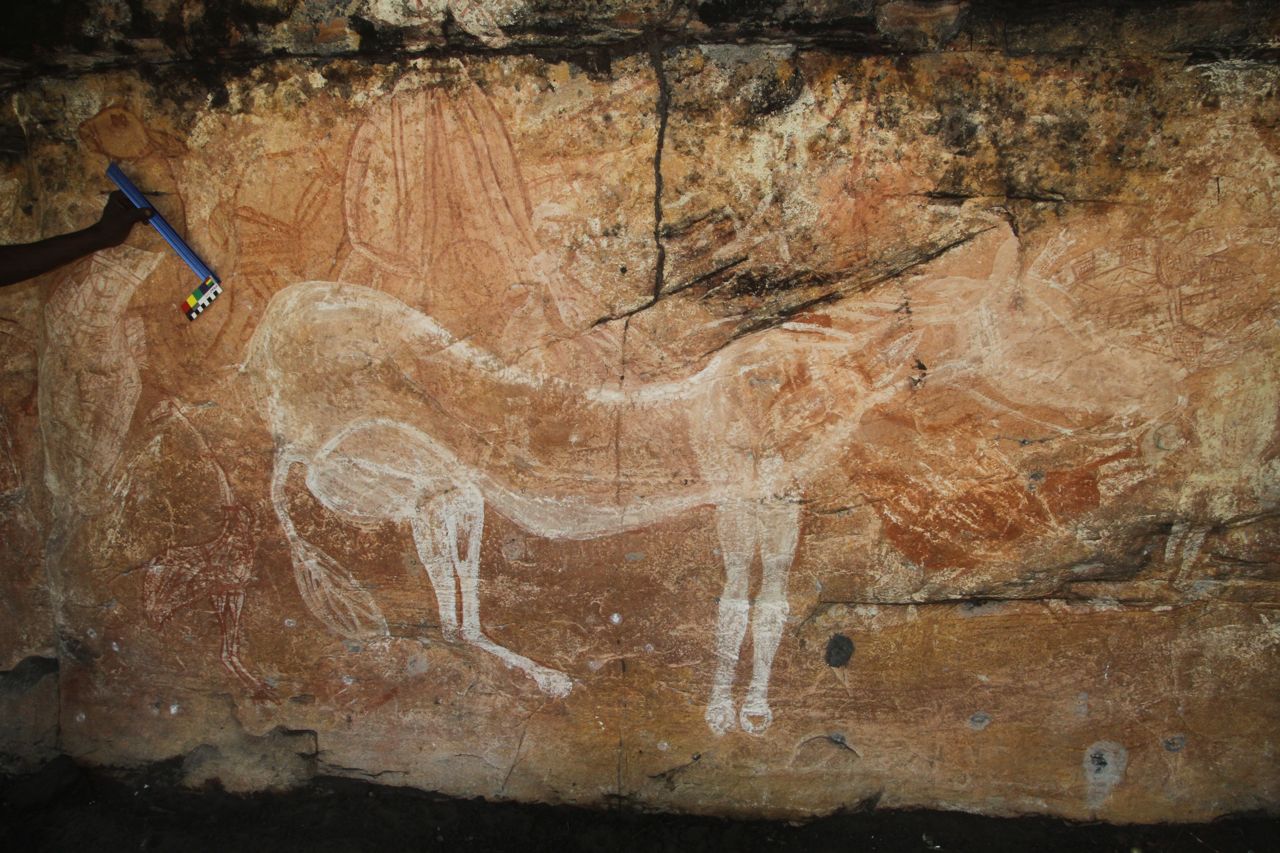Nabangardi Kayolyolme Kunwardderurrkken
Terrah talks about Rock Shelters
July 2, 2012
Djarrang kore Enamaraway, Wamud Namok ba-bimbom c1950s wanjh kum-durndi 1996 wanjh ba-yawoyhbimkerrngehwong djarrang.
Horse (and rider) at Enamaraway by Wamud Namok, painted c1950s and then again in 1996 he returned to renew the horse image again.
Story by Nabangardi Nabordoh about life in rock shelters.
Inspired by a visit to sites in Djordi clan country at Enamaraway and Dumebe
Recorded by Alys Stevens, photo by Peter Cooke
[00:00:08] mm manekke kunwardde
Yes, that rock [shelter]
[00:00:11] yiman kayime Enamaraway, Dumebe manwarddekuken dabbarrabbolk korroko barriyoy yiman
such as at Enamaraway and Dumebe which are important traditional camping places for our ancestors who lived there long ago
[00:00:20] dabbarrabbolk yiman kayime nawu kakkak, doydoyh
the ancestors such as my grandparents and great grandparents
[00:00:27] djongok and then nawu bewuh mak nawu birriyungki duninj nawu birriyoy
and my in-laws and then before them, there were other early ancestors who lived here
[00:00:35] bindiwaddabukkahbukkang nawu anwaddakuken korroko birriyoy
They passed on knowledge about these traditional camping places to the next generation
[00:00:38] like yiman ngad nawu bininj karrkakarrkad
like us, the people who live up on the higher country
[00:00:43] nawu kuwarddehwardde birriyoy
there where they lived in the rock country
[00:00:46] kunwardde wanjh manekke kurrambalk bedberreni yiman bolkkime ngarrkarrme kurrambalk
Our ancestors lived in these rock shelters which were their houses, but we live in other houses
[00:00:50] kunkukbelebeh bedda makkanj mane kurrambalk bedberreni
the houses introduced to us by white people, but these [rock shelters] were their houses [the ancestors]
[00:00:55] birribolkbodmerawoni yiman kayime njamed dolobbo birrikurrmi
They enclosed all along the side of the shelter with stringybark
[00:00:58] birriyoy
and camped there
[00:01:00] kume wurdurd bindibukkabukkani daluk bu birrikarungi bedman njamed
The women would teach their children how to dig whatsit
[00:01:03] kayawal birribuni njalenjale
long yams and other foods
[00:01:06] anburre mak ...[pause] manyong yiman kayime
such as bush radish (Decaschistia byrnesii) called anburre or manyong
[00:01:13] bedman bininj start birrimey kume borndok birrimangi
that was in the time when men walked around taking their spear throwers
[00:01:16] bedman daluk birrimey kume bedman kundjadj birrimangi, korroko
and the women would take with them their digging sticks, long ago
[00:01:19] wanjh manborndok birriwanawam bedman kundjadj birringolkani daluk
so that men went with spear throwers and women with their digging sticks
[00:01:25] kubebeh, start birriyimi birriyoy
from the time they started living there [in these rock shelters]
[00:01:30] (someone) kunlenj (inaudible)
[and they gave] gifts of meat to their in-laws
[00:01:30] lenjno
gifts to in-laws [affinal prestations]
[00:01:31] kunmurrng bindimarnemurrngkurrmi
and they laid out the bones of their dead for each other
[00:01:35] bindimarnemurrngbarungi kume yerre kuwardde
and they painted those bones with ochre there in the rock shelters
[00:01:45] mak bu ...
and also
[00:01:49] bu kundarrkid kumeke birriyoy manek... birriyoy manu bu birriyakwong wanjh bonj bindikurrmi wanjh bindidudjengi kunbuyika birridudjengi o bindiyawoyhkarungi
when they were alive, they lived there... they camped there and when they died, they would place them [in the rock shelter] and bury them at another place and later they might dig them up again [in a disinterment ceremony]
[00:01:57] yimarnek manek mandjewk ankudji bindihkarungi bindimurrngbebkeni
they might wait for a year and then disinter the bones, taking them out
[00:01:59] o yika bindikukkurrmi kore njamed kalawu
or sometimes they were placed up on a mortuary platform
[00:02:02] bindihmurrng... njamed wanjh bindiwelengmurrngbarungi bindikurrmi kore lorrkkon
they would then paint the bones with ochre and prepare them for a lorrkkon hollow log ossuary ceremony
[00:02:06] lorrkkon biwelengkarrmeng wanjh
they would finally rest in a hollow log coffin
[00:02:07] birriyikolungi birriwelengkani namud all the families
they would bring all the family together into the camp [to complete the lorrkkon ceremony]
[00:02:12] bindikokbokayinj wanjh
they would lead the people out as they called out 'kokbo kokbo'
[00:02:14] djabdi yimane birridjabnami djaldi wanjh manek kumek wanjh bidurndiweninj
then the hollow log was stood upright into its final resting place
[00:02:18] mane kumekke birrurrkmangi durndi wanjh kuwardde
and then they would return to the stone country
[00:02:21] wanjh yawoyhdurndi kuwardde bikodj ngad karriwarddewaken bininj wanjh kume'e kumeke ankarre kayime, that's our life and people of this warddeken birriyoy kunkare
they would go back to the stone country because we are people who belong to the stone country and that is our way of life, the people of the stone country who have have lived here since ancient times
Bonj
That is all.